




An Introduction to Surface Area of Solids of Various Shapes
Three-dimensional shapes' surface area is one of their most essential characteristics. The surface area of a shape is a topic that comes up frequently in geometry. Using a general formula for surface area, it is possible to solve the objects having simple shapes and forms. We will need to use our understanding of one or more 2-dimensional shapes to handle more challenging shapes.
In this article, we will find the surface area of cube and cuboid as well as cylinder. Moreover, we will determine the formula of total surface area of cuboid, cube and cylinder. We can readily determine their surface area and volume using the established equations. Have you ever considered what may happen if these fundamental shapes combined to create a new shape? How will we determine the new shape's capacity then? This is explained in the article that follows.
Surface Area Definition
Any solid shape's surface area is equal to the sum of all of its faces' respective areas. For instance, we add the areas of each of the rectangles that make up a cuboid to determine its surface area. When calculating the surface area of complex shapes, the combined area of all the surfaces of the shapes that make up a complex structure is calculated.
There are Primarily Two Categories of Areas:
Total Surface Area
Curved Surface Area/Lateral Surface Area
Total Surface Area
The total surface area is the area that includes the base(s) and the curving portion. It is the overall area that the object's surface occupies. If the shape has a curved base and surface, the total area will be equal to the sum of the two areas.
Curved Surface Area/Lateral Surface Area
The area of just the curved part of the shape, excluding its base(s), is referred to as the curved surface area. For shapes like a cylinder, it is sometimes referred to as the lateral surface area.
The Below Table shows the Surface Area of the Various Shaped Objects:
Surface Area of Cuboid Formula
Total Surface Area of Cuboid : The surface areas of each of the six sides can be added up to determine their total area. Due to the fact that a cuboid's faces are all rectangles, the total surface area of the cuboid is determined by adding the areas of each rectangle on each face. With the guidance of the following figure, let's understand this better.
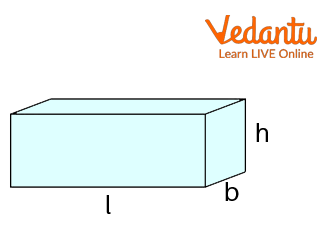
A Cuboid
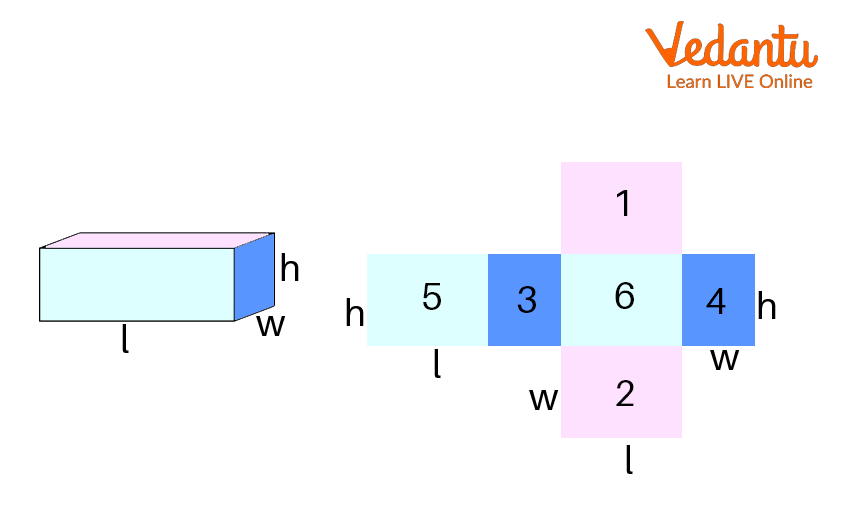
Cuboid with Different Faces
According to the figure above, all of the faces are numbered
Area of rectangles
Area of rectangles
Area of rectangles
The surface area of the six faces is, therefore, equal to
Lateral Surface Area of Cuboid : The total surface area of a cuboid's four vertical sides makes up its lateral surface area of the cuboid. If the top and bottom faces are taken out of the above figure, the lateral surface area of the cuboid will be identified. The cuboid's lateral surface area is
Total Surface Area
Lateral Surface Area
Surface Area of Cube Formula
Total Surface Area of Cube :To determine the area filled by the six surfaces, use the cube's total surface area formula. The cube's total surface area is calculated by multiplying the square of the side length by six. As a result, the formula for the cube's surface area with side length "
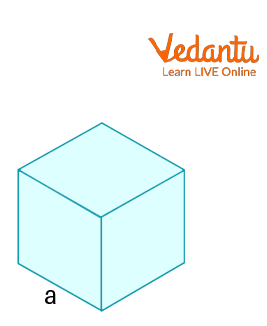
A Cube
Lateral Surface Area of Cube : The area occupied by the
Surface Area of Cylinder Formula
Curved/Lateral Surface Area of Cylinder : A cylinder's curved surface area is the area that is entirely covered by its curved surface. The curved surface area of a cylinder is estimated using the formula below if the height of the cylinder is
Lateral surface area of cylinder
Total Surface Area of Cylinder : The area of the two bases as well as the area of the curved surface are added to determine the cylinder's total surface area. Consequently, the following is the formula for the cylinder's total surface area:
Area of the two bases
Due to the cylinder's circular bases, their total area will be equal to
The cylinder's total surface area is
Cylinder's total surface area is equal to
Formulation for the Surface Area of a Cylinder : Any shape's area is the space it occupies. A cylinder has a curving surface that unfolds into a rectangle and two flat surfaces that are both circulars. Look at the cylinder with the provided height ("
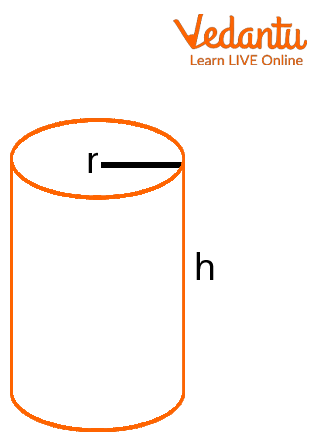
Cylinder
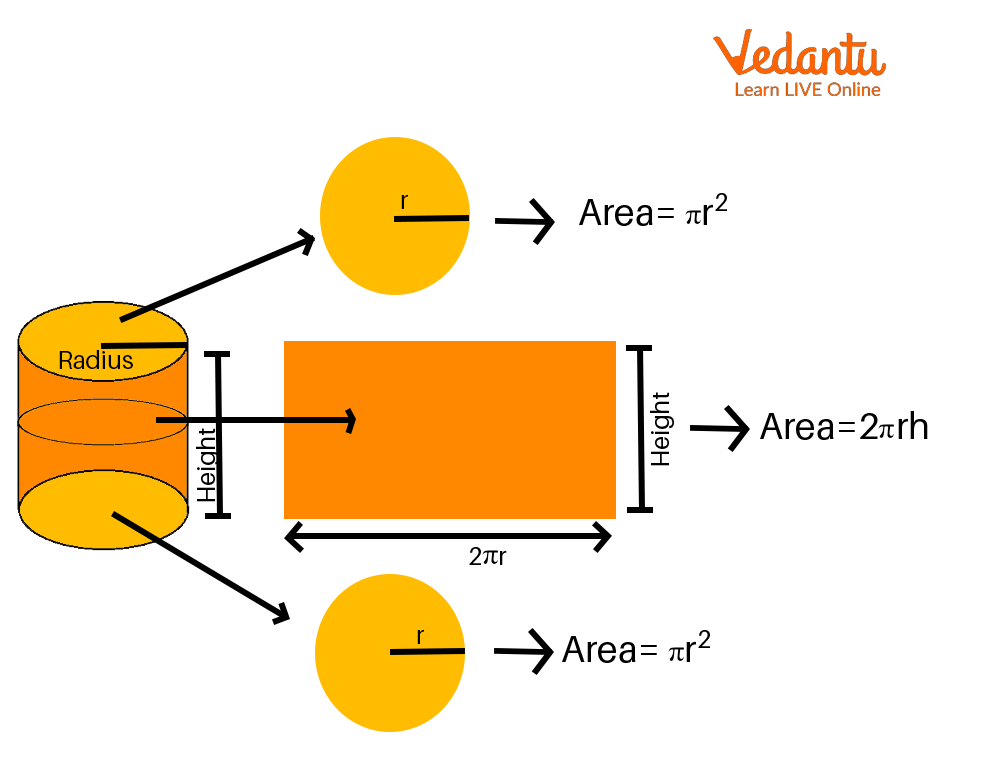
Cylinder Expanded in the Shape of a Rectangle
Look at the figure above, where the two bases are circles and the area of the curved surface expands up as a rectangle.
The area of the two curves is now
One side of the rectangle corresponds to the cylinder's height,
The area of this rectangle
As a result, the cylinder's total surface area is equal to
Solved Examples
Q.1. Determine the total surface area of a cubic construction whose sidewalls are
Solution: Given that the sidewall's length is
Using the formula, we are aware that
Total Surface Area is
Total Surface Area
Q.2. Determine the surface area of a cylindrical tank with a radius of
Solution: We are aware that the formula for a cylinder's total surface area is:
Total Surface Area
Painting costs come out to
The cost of the artwork is
Q.3. Determine the cuboid's total surface area and lateral surface area. Its dimensions are
Solution: As is general information, a cuboid's total surface area is equal to
Here, the dimensions are
Total surface area of the cuboid is equal to
Cuboid's total surface area
Cuboid's lateral surface area is equal to
As a result, the cuboid's lateral surface area is
Practice Questions
1. Obtain the surface area of the cube where the edge is
2. Identify the total surface area of a cylindrical container with a
Answers
1.
2.
Summary
The surface area of an object is the total area occupied by all of its surfaces. Two categories—Curved Surface Area (CSA) and Lateral Surface Area (LSA), respectively—are used to categorise the surface's area (TSA). The term "curved surface area," also referred to as "lateral surface area," refers to the surface area of a surface which is curved in shape. The bottom and top sections, as well as the lateral surface area, make up the overall surface area. The three-dimensional shapes' surface areas are included in this article. It greatly facilitates the speedy resolution of issues based on it.






FAQs on Surface Area of Solids of Various Shapes (Cube Cuboid and Cylinder)
1. Define a cylinder.
One of the fundamental three-dimensional shapes in geometry is the cylinder, which has two distantly spaced parallel circular bases. A curving surface located a set distance from the centre connects the two circular bases. The axis of the cylinder is the line segment that connects the centres of two circular bases. The height of the cylinder is defined as the separation between the two circular bases. One of the actual instances of cylinders is the LPG gas cylinder. The cylinder has two main characteristics because it is a three-dimensional shape: surface area and volume.
2. Are the curved surface area and total surface area similar?
Curved Surface Area (CSA), the term refers to the entire area of all the curved surfaces. The term "lateral surface area" (LSA) refers to the total area of the surface, apart from the top and bottom areas.
Total Surface Area (TSA): This measurement considers the area of the bases as well as all of the object's surface.
3. Describe the differences between volume and surface area.
The area that an object occupies on its surface is referred to as its surface area. Geometry includes a wide range of shapes and dimensions, including spheres, cubes, cuboid shapes, cones, and cylinders, among others, whereas volume specifies how much space it has. We can only measure the area of two-dimensional shapes like squares, circles, rectangles, triangles, and so on because there is no volume present.




































